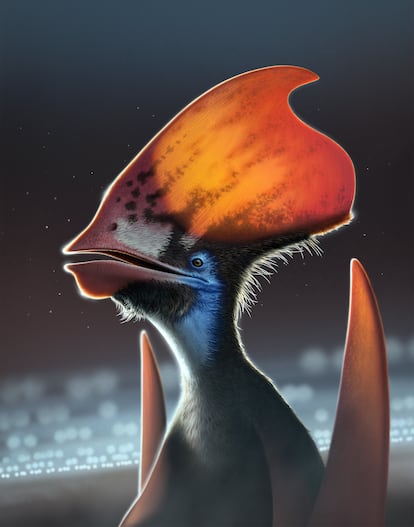Pterosaurs could change the color of their feathers
The decorative plumage played an important role in visual communication, according to a new study

A group of scientists revealed on Wednesday that pterosaurs, prehistoric flying reptiles, had the ability to change the color of their feathers by changing the shapes of the melanosomes, microscopic granules that enclose melanin. Until now, that ability had only been known to exist in theropod dinosaurs and birds. The conclusions, published in the science journal Nature, are based on an analysis of a partial skull of Tupandactylus imperator, a pterosaur found in Brazil that dates from the Early Cretaceous, approximately 113 million years ago. The animals’ feathers not only served an ornamental function, they also played an important role in visual communication. Although scientists do not have the dinosaur’s whole body, and therefore cannot know with certainty, they posit that the feathers could also have been used for insulation and thermoregulation.
The fossil was in the hands of a private collector who offered the remains to the scientists for analysis. The remains included the posterior part of the skull comprising part of the left orbit, the left naso-orbital opening and a fibrous cranial crest. The crest led the researchers to begin the study, since the soft tissues were well preserved. (The tissues later helped the scientists confirm the use of the feathers.) The scientists observed two types of feathers on the cranial crest: smaller, unbranched monofilaments and larger, branching structures that look more like modern bird feathers. The overall findings suggest that although these feathers may not have been used for flight, they were a form of visual communication.
Scientific researchers had previously discovered that pterosaurs had fluffy fur with hair-like fibers known as pycnofibers, but it was unclear whether or not the structures were true feathers. This study confirms that the reptiles had feathers. In addition, the paper claims that pterosaurs could produce melanosomes of different shapes, associated with different colors. Maria McNamara, a paleobiologist at University College Cork, Ireland, and one of the authors of the study, explains that in this respect, pterosaurs are just like modern birds. “If we want to know how feathers evolved, we must look for older fossils, starting with those from the Triassic Period,” she says. She encourages scientists to go back and analyze other pterosaur fossils that have well-preserved soft tissues. McNamara also indicates another hypothesis: “It is possible that the feathers evolved as a kind of adaptation to the changes that occurred on our planet, and that the animals that survived had that advantage. It’s something we need to research.”
This is not the first study to suggest that pterosaurs have feathers. In 2019, a study published in Nature Ecology and Evolution showed that two specimens of pterosaurs, specifically anurognathid pterosaurs, presented structures with similar characteristics as feathers. Those creatures lived more than 100 million years ago, and their fossil remains were found in China. The paper concluded that feathers could either have deep evolutionary origins in ancient archosaurs, or they could have evolved independently in pterosaurs.
Pterosaurs are flying reptiles that dominated the Mesozoic skies for 160 million years. They were the first vertebrates to develop powered flight, and they encompassed more than 100 species, including the largest flying animals of all time, according to a 2018 publication from the Geological Society of London.
Tu suscripción se está usando en otro dispositivo
¿Quieres añadir otro usuario a tu suscripción?
Si continúas leyendo en este dispositivo, no se podrá leer en el otro.
FlechaTu suscripción se está usando en otro dispositivo y solo puedes acceder a EL PAÍS desde un dispositivo a la vez.
Si quieres compartir tu cuenta, cambia tu suscripción a la modalidad Premium, así podrás añadir otro usuario. Cada uno accederá con su propia cuenta de email, lo que os permitirá personalizar vuestra experiencia en EL PAÍS.
¿Tienes una suscripción de empresa? Accede aquí para contratar más cuentas.
En el caso de no saber quién está usando tu cuenta, te recomendamos cambiar tu contraseña aquí.
Si decides continuar compartiendo tu cuenta, este mensaje se mostrará en tu dispositivo y en el de la otra persona que está usando tu cuenta de forma indefinida, afectando a tu experiencia de lectura. Puedes consultar aquí los términos y condiciones de la suscripción digital.
More information
Últimas noticias
Most viewed
- Reinhard Genzel, Nobel laureate in physics: ‘One-minute videos will never give you the truth’
- Oona Chaplin: ‘I told James Cameron that I was living in a treehouse and starting a permaculture project with a friend’
- Pablo Escobar’s hippos: A serious environmental problem, 40 years on
- Charles Dubouloz, mountaineering star, retires at 36 with a farewell tour inspired by Walter Bonatti
- Why we lost the habit of sleeping in two segments and how that changed our sense of time











































